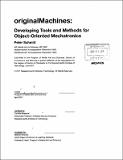| dc.contributor.advisor | Cynthis Breazeal. | en_US |
| dc.contributor.author | Schmitt, Peter (Peter Alfons) | en_US |
| dc.contributor.other | Massachusetts Institute of Technology. Dept. of Architecture. Program in Media Arts and Sciences. | en_US |
| dc.date.accessioned | 2011-12-19T18:48:05Z | |
| dc.date.available | 2011-12-19T18:48:05Z | |
| dc.date.copyright | 2011 | en_US |
| dc.date.issued | 2011 | en_US |
| dc.identifier.uri | http://hdl.handle.net/1721.1/67761 | |
| dc.description | Thesis (Ph. D.)--Massachusetts Institute of Technology, School of Architecture and Planning, Program in Media Arts and Sciences, 2011. | en_US |
| dc.description | Cataloged from PDF version of thesis. | en_US |
| dc.description | Includes bibliographical references (p. [161]-166). | en_US |
| dc.description.abstract | The digital revolution has fundamentally changed our lives by giving us new ways to express ourselves through digital media. For example, accessible multimedia content creation tools allow people to instantiate their ideas and share them easily. However, most of these outcomes only exist on-screen and online. Despite the growing accessibility of digital design and fabrication tools the physical world and everyday objects surrounding us have been largely excluded from a parallel explosion of possibilities to express ourselves. Increasingly, webbased services allow professional and non-professional audiences to access computer-aided manufacturing (CAM) tools like 3D-printing and laser-cutting. Nonetheless, there are few (if any) design tools and methods for creating complex mechanical assemblies that take full advantage of CAM systems. Creating unique mechatronic artifacts or "originalMachines" requires more specific and sophisticated design tools than exist today. "Object-Oriented Mechatronics" is a parametric design approach that connects knowledge about mechanical assemblies and electronics with the requirements of digital manufacturing processes. Parametric instances like gears, bearing and servos are made available as objects within a CAD environment which can then be implemented into specific projects. The approach addresses the missing link between accessible rapid-manufacturing services and currently available design tools thereby creating new opportunities for self-expression through mechatronic objects and machines. The dissertation matches mechanical components and assemblies with rapid manufacturing methods by exploring transferability of conventional manufacturing techniques to appropriate rapid manufacturing tools. I rebuild various gearing and bearing principles like four-contact point bearings, cross roller bearings, spur and helical gears, planetary gears, cycloidal and harmonic gear reducers using the laser cutter, the CNC-mill and the 3D-printer. These explorations lead to more complex assemblies such as the PlywoodServo, 3DprintedClock and 3-DoF (Degree of Freedom) Head. The lessons from these explorations are summarized in a detailed "cook book" of novel mechatronic assemblies enabled by new fabrication tools. Furthermore, I use the results to develop a CAD tool that brings together several existing software packages and plug-ins including Rhino, Grasshopper and the Firefly experiments for Arduino, which will allow animation, fabrication and control of original machines. The tool is an example of an object-oriented design approach to mechatronic assemblies. A user calls a DoF (Degree of Freedom) object (parametric servo) with specific parameters like gearing and bearing types, motor options and control and communication capabilities. The DoF object then creates the corresponding geometry which can be connected and integrated with other actuators and forms. A group of roboticists and designers participated in a workshop to test the tool and make proposals for original machines using the tool. The dissertation has contributions on multiple levels. First, the actuator assembly examples and parametric design tool present a body of novel work that illustrates the benefits of going beyond off-the-shelf actuator assemblies and kit-of-parts for robotic objects. Second, this tool and the accompanying examples enable the design of more original machines with custom actuator assemblies using the latest digital fabrication tools. Finally, these explorations illustrate how new CAD/ CAM tools can facilitate an exchange between more design-oriented users and more engineering-oriented users. | en_US |
| dc.description.statementofresponsibility | by Peter Schmitt. | en_US |
| dc.format.extent | 198 p. | en_US |
| dc.language.iso | eng | en_US |
| dc.publisher | Massachusetts Institute of Technology | en_US |
| dc.rights | M.I.T. theses are protected by
copyright. They may be viewed from this source for any purpose, but
reproduction or distribution in any format is prohibited without written
permission. See provided URL for inquiries about permission. | en_US |
| dc.rights.uri | http://dspace.mit.edu/handle/1721.1/7582 | en_US |
| dc.subject | Architecture. Program in Media Arts and Sciences. | en_US |
| dc.title | originalMachines : developing tools and methods for object-oriented mechatronics | en_US |
| dc.title.alternative | Original Machines | en_US |
| dc.title.alternative | Developing tools and methods for object-oriented mechatronics | en_US |
| dc.type | Thesis | en_US |
| dc.description.degree | Ph.D. | en_US |
| dc.contributor.department | Program in Media Arts and Sciences (Massachusetts Institute of Technology) | |
| dc.identifier.oclc | 766791163 | en_US |
